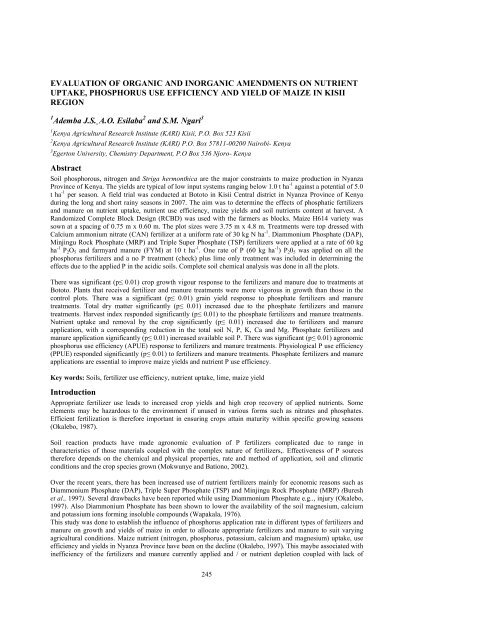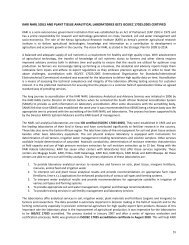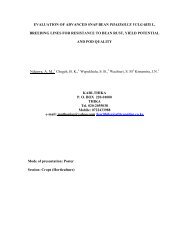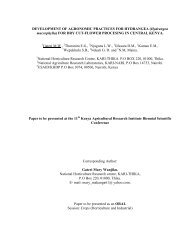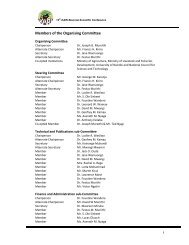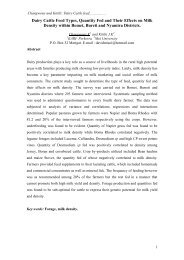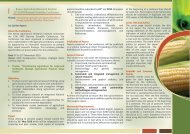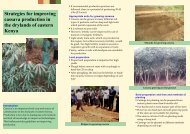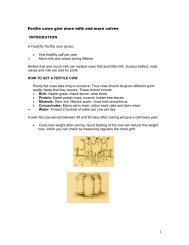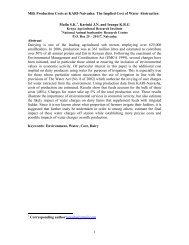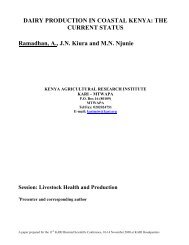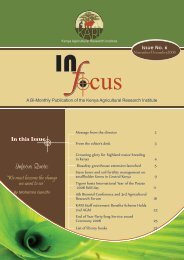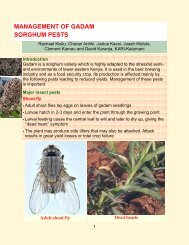evaluation of organic and inorganic amendments on nutrient uptake ...
evaluation of organic and inorganic amendments on nutrient uptake ...
evaluation of organic and inorganic amendments on nutrient uptake ...
You also want an ePaper? Increase the reach of your titles
YUMPU automatically turns print PDFs into web optimized ePapers that Google loves.
EVALUATION OF ORGANIC AND INORGANIC AMENDMENTS ON NUTRIENT<br />
UPTAKE, PHOSPHORUS USE EFFICIENCY AND YIELD OF MAIZE IN KISII<br />
REGION<br />
1 Ademba J.S. , A.O. Esilaba 2 <str<strong>on</strong>g>and</str<strong>on</strong>g> S.M. Ngari 3<br />
1 Kenya Agricultural Research Institute (KARI) Kisii, P.O. Box 523 Kisii<br />
2 Kenya Agricultural Research Institute (KARI) P.O. Box 57811-00200 Nairobi- Kenya<br />
3 Egert<strong>on</strong> University, Chemistry Department, P.O Box 536 Njoro- Kenya<br />
Abstract<br />
Soil phosphorous, nitrogen <str<strong>on</strong>g>and</str<strong>on</strong>g> Striga herm<strong>on</strong>thica are the major c<strong>on</strong>straints to maize producti<strong>on</strong> in Nyanza<br />
Province <str<strong>on</strong>g>of</str<strong>on</strong>g> Kenya. The yields are typical <str<strong>on</strong>g>of</str<strong>on</strong>g> low input systems ranging below 1.0 t ha -1 against a potential <str<strong>on</strong>g>of</str<strong>on</strong>g> 5.0<br />
t ha -1 per seas<strong>on</strong>. A field trial was c<strong>on</strong>ducted at Bototo in Kisii Central district in Nyanza Province <str<strong>on</strong>g>of</str<strong>on</strong>g> Kenya<br />
during the l<strong>on</strong>g <str<strong>on</strong>g>and</str<strong>on</strong>g> short rainy seas<strong>on</strong>s in 2007. The aim was to determine the effects <str<strong>on</strong>g>of</str<strong>on</strong>g> phosphatic fertilizers<br />
<str<strong>on</strong>g>and</str<strong>on</strong>g> manure <strong>on</strong> <strong>nutrient</strong> <strong>uptake</strong>, <strong>nutrient</strong> use efficiency, maize yields <str<strong>on</strong>g>and</str<strong>on</strong>g> soil <strong>nutrient</strong>s c<strong>on</strong>tent at harvest. A<br />
R<str<strong>on</strong>g>and</str<strong>on</strong>g>omized Complete Block Design (RCBD) was used with the farmers as blocks. Maize H614 variety was<br />
sown at a spacing <str<strong>on</strong>g>of</str<strong>on</strong>g> 0.75 m x 0.60 m. The plot sizes were 3.75 m x 4.8 m. Treatments were top dressed with<br />
Calcium amm<strong>on</strong>ium nitrate (CAN) fertilizer at a uniform rate <str<strong>on</strong>g>of</str<strong>on</strong>g> 30 kg N ha -1 . Diamm<strong>on</strong>ium Phosphate (DAP),<br />
Minjingu Rock Phosphate (MRP) <str<strong>on</strong>g>and</str<strong>on</strong>g> Triple Super Phosphate (TSP) fertilizers were applied at a rate <str<strong>on</strong>g>of</str<strong>on</strong>g> 60 kg<br />
ha -1 P 2 O 5 <str<strong>on</strong>g>and</str<strong>on</strong>g> farmyard manure (FYM) at 10 t ha -1 . One rate <str<strong>on</strong>g>of</str<strong>on</strong>g> P (60 kg ha -1 ) P 2 0 5 was applied <strong>on</strong> all the<br />
phosphorus fertilizers <str<strong>on</strong>g>and</str<strong>on</strong>g> a no P treatment (check) plus lime <strong>on</strong>ly treatment was included in determining the<br />
effects due to the applied P in the acidic soils. Complete soil chemical analysis was d<strong>on</strong>e in all the plots.<br />
There was significant (p≤ 0.01) crop growth vigour resp<strong>on</strong>se to the fertilizers <str<strong>on</strong>g>and</str<strong>on</strong>g> manure due to treatments at<br />
Bototo. Plants that received fertilizer <str<strong>on</strong>g>and</str<strong>on</strong>g> manure treatments were more vigorous in growth than those in the<br />
c<strong>on</strong>trol plots. There was a significant (p≤ 0.01) grain yield resp<strong>on</strong>se to phosphate fertilizers <str<strong>on</strong>g>and</str<strong>on</strong>g> manure<br />
treatments. Total dry matter significantly (p≤ 0.01) increased due to the phosphate fertilizers <str<strong>on</strong>g>and</str<strong>on</strong>g> manure<br />
treatments. Harvest index resp<strong>on</strong>ded significantly (p≤ 0.01) to the phosphate fertilizers <str<strong>on</strong>g>and</str<strong>on</strong>g> manure treatments.<br />
Nutrient <strong>uptake</strong> <str<strong>on</strong>g>and</str<strong>on</strong>g> removal by the crop significantly (p≤ 0.01) increased due to fertilizers <str<strong>on</strong>g>and</str<strong>on</strong>g> manure<br />
applicati<strong>on</strong>, with a corresp<strong>on</strong>ding reducti<strong>on</strong> in the total soil N, P, K, Ca <str<strong>on</strong>g>and</str<strong>on</strong>g> Mg. Phosphate fertilizers <str<strong>on</strong>g>and</str<strong>on</strong>g><br />
manure applicati<strong>on</strong> significantly (p≤ 0.01) increased available soil P. There was significant (p≤ 0.01) agr<strong>on</strong>omic<br />
phosphorus use efficiency (APUE) resp<strong>on</strong>se to fertilizers <str<strong>on</strong>g>and</str<strong>on</strong>g> manure treatments. Physiological P use efficiency<br />
(PPUE) resp<strong>on</strong>ded significantly (p≤ 0.01) to fertilizers <str<strong>on</strong>g>and</str<strong>on</strong>g> manure treatments. Phosphate fertilizers <str<strong>on</strong>g>and</str<strong>on</strong>g> manure<br />
applicati<strong>on</strong>s are essential to improve maize yields <str<strong>on</strong>g>and</str<strong>on</strong>g> <strong>nutrient</strong> P use efficiency.<br />
Key words: Soils, fertilizer use efficiency, <strong>nutrient</strong> <strong>uptake</strong>, lime, maize yield<br />
Introducti<strong>on</strong><br />
Appropriate fertilizer use leads to increased crop yields <str<strong>on</strong>g>and</str<strong>on</strong>g> high crop recovery <str<strong>on</strong>g>of</str<strong>on</strong>g> applied <strong>nutrient</strong>s. Some<br />
elements may be hazardous to the envir<strong>on</strong>ment if unused in various forms such as nitrates <str<strong>on</strong>g>and</str<strong>on</strong>g> phosphates.<br />
Efficient fertilizati<strong>on</strong> is therefore important in ensuring crops attain maturity within specific growing seas<strong>on</strong>s<br />
(Okalebo, 1987).<br />
Soil reacti<strong>on</strong> products have made agr<strong>on</strong>omic <str<strong>on</strong>g>evaluati<strong>on</strong></str<strong>on</strong>g> <str<strong>on</strong>g>of</str<strong>on</strong>g> P fertilizers complicated due to range in<br />
characteristics <str<strong>on</strong>g>of</str<strong>on</strong>g> those materials coupled with the complex nature <str<strong>on</strong>g>of</str<strong>on</strong>g> fertilizers,. Effectiveness <str<strong>on</strong>g>of</str<strong>on</strong>g> P sources<br />
therefore depends <strong>on</strong> the chemical <str<strong>on</strong>g>and</str<strong>on</strong>g> physical properties, rate <str<strong>on</strong>g>and</str<strong>on</strong>g> method <str<strong>on</strong>g>of</str<strong>on</strong>g> applicati<strong>on</strong>, soil <str<strong>on</strong>g>and</str<strong>on</strong>g> climatic<br />
c<strong>on</strong>diti<strong>on</strong>s <str<strong>on</strong>g>and</str<strong>on</strong>g> the crop species grown (Mokwunye <str<strong>on</strong>g>and</str<strong>on</strong>g> Bati<strong>on</strong>o, 2002).<br />
Over the recent years, there has been increased use <str<strong>on</strong>g>of</str<strong>on</strong>g> <strong>nutrient</strong> fertilizers mainly for ec<strong>on</strong>omic reas<strong>on</strong>s such as<br />
Diamm<strong>on</strong>ium Phosphate (DAP), Triple Super Phosphate (TSP) <str<strong>on</strong>g>and</str<strong>on</strong>g> Minjingu Rock Phosphate (MRP) (Buresh<br />
et al., 1997). Several drawbacks have been reported while using Diamm<strong>on</strong>ium Phosphate e.g.., injury (Okalebo,<br />
1997). Also Diamm<strong>on</strong>ium Phosphate has been shown to lower the availability <str<strong>on</strong>g>of</str<strong>on</strong>g> the soil magnesium, calcium<br />
<str<strong>on</strong>g>and</str<strong>on</strong>g> potassium i<strong>on</strong>s forming insoluble compounds (Wapakala, 1976).<br />
This study was d<strong>on</strong>e to establish the influence <str<strong>on</strong>g>of</str<strong>on</strong>g> phosphorus applicati<strong>on</strong> rate in different types <str<strong>on</strong>g>of</str<strong>on</strong>g> fertilizers <str<strong>on</strong>g>and</str<strong>on</strong>g><br />
manure <strong>on</strong> growth <str<strong>on</strong>g>and</str<strong>on</strong>g> yields <str<strong>on</strong>g>of</str<strong>on</strong>g> maize in order to allocate appropriate fertilizers <str<strong>on</strong>g>and</str<strong>on</strong>g> manure to suit varying<br />
agricultural c<strong>on</strong>diti<strong>on</strong>s. Maize <strong>nutrient</strong> (nitrogen, phosphorus, potassium, calcium <str<strong>on</strong>g>and</str<strong>on</strong>g> magnesium) <strong>uptake</strong>, use<br />
efficiency <str<strong>on</strong>g>and</str<strong>on</strong>g> yields in Nyanza Province have been <strong>on</strong> the decline (Okalebo, 1997). This maybe associated with<br />
inefficiency <str<strong>on</strong>g>of</str<strong>on</strong>g> the fertilizers <str<strong>on</strong>g>and</str<strong>on</strong>g> manure currently applied <str<strong>on</strong>g>and</str<strong>on</strong>g> / or <strong>nutrient</strong> depleti<strong>on</strong> coupled with lack <str<strong>on</strong>g>of</str<strong>on</strong>g><br />
245
suitable fertilizer applicati<strong>on</strong> rates <str<strong>on</strong>g>and</str<strong>on</strong>g> soil acidity since the current research recommendati<strong>on</strong>s were developed<br />
more than two decades ago (FURP,1994). The extent <str<strong>on</strong>g>of</str<strong>on</strong>g> <strong>nutrient</strong> depleti<strong>on</strong> is unknown <str<strong>on</strong>g>and</str<strong>on</strong>g> phosphate fertilizer<br />
<str<strong>on</strong>g>and</str<strong>on</strong>g> manure applicati<strong>on</strong> by farmers is not commensurate with the plant requirements <str<strong>on</strong>g>and</str<strong>on</strong>g> / or <strong>nutrient</strong> levels in<br />
the soil. Twenty years have elapsed since the last fertilizer use recommendati<strong>on</strong> was carried out in Kisii districts.<br />
Declining yields <str<strong>on</strong>g>of</str<strong>on</strong>g> maize which accounts for a significant proporti<strong>on</strong> <str<strong>on</strong>g>of</str<strong>on</strong>g> the food diet for smallholder mixed<br />
farms <str<strong>on</strong>g>of</str<strong>on</strong>g> Kisii districts has raised c<strong>on</strong>cerns about food security. There was therefore need to determine the<br />
<strong>nutrient</strong> use efficiencies <str<strong>on</strong>g>of</str<strong>on</strong>g> phosphate fertilizers <str<strong>on</strong>g>and</str<strong>on</strong>g> manure <str<strong>on</strong>g>and</str<strong>on</strong>g> their effects in acidic soils <str<strong>on</strong>g>of</str<strong>on</strong>g> smallholder<br />
mixed farms. It was necessary to develop appropriate recommendati<strong>on</strong>s that can be used by smallholder<br />
resource poor farmers <str<strong>on</strong>g>and</str<strong>on</strong>g> extensi<strong>on</strong> agents. The appropriate recommendati<strong>on</strong>s <str<strong>on</strong>g>of</str<strong>on</strong>g> rates <str<strong>on</strong>g>of</str<strong>on</strong>g> fertilizers <str<strong>on</strong>g>and</str<strong>on</strong>g> manure<br />
in different soils <str<strong>on</strong>g>and</str<strong>on</strong>g> climatic c<strong>on</strong>diti<strong>on</strong>s may help check the deteriorating soil c<strong>on</strong>diti<strong>on</strong>s <str<strong>on</strong>g>and</str<strong>on</strong>g> improve food<br />
security in Bototo. Therefore the objective <str<strong>on</strong>g>of</str<strong>on</strong>g> this study was to determine suitable phosphorous fertilizers <str<strong>on</strong>g>and</str<strong>on</strong>g><br />
manure applicati<strong>on</strong> rates <str<strong>on</strong>g>and</str<strong>on</strong>g> their effects <strong>on</strong> maize producti<strong>on</strong> in acidic soils in Kenya.<br />
Materials <str<strong>on</strong>g>and</str<strong>on</strong>g> Methods<br />
Field experiment was c<strong>on</strong>ducted in a farm site in Bototo having an altitude <str<strong>on</strong>g>of</str<strong>on</strong>g> 1590 masl, 34 0 44’E <str<strong>on</strong>g>and</str<strong>on</strong>g> 0 0 39’S<br />
<str<strong>on</strong>g>and</str<strong>on</strong>g> 1200 – 2100 mm rainfall. The soils are mollic Nitisols or s<str<strong>on</strong>g>and</str<strong>on</strong>g>y loam Nitisols with moderately high fertility<br />
(Jaetzold <str<strong>on</strong>g>and</str<strong>on</strong>g> Schmidt, 2006). Maize is planted twice annually, during the l<strong>on</strong>g rains (March – July) <str<strong>on</strong>g>and</str<strong>on</strong>g> short<br />
rains (August – December).<br />
The experimental design was R<str<strong>on</strong>g>and</str<strong>on</strong>g>omized Complete Block Design (RCBD) with selected farmers as blocks (ten<br />
men <str<strong>on</strong>g>and</str<strong>on</strong>g> ten women).<br />
The treatments were:<br />
i). No phosphorus fertilizer used at planting -c<strong>on</strong>trol<br />
ii). Lime <strong>on</strong>ly - 250 kg ha -1 CaCO 3<br />
iii). Diamm<strong>on</strong>ium Phosphate (DAP) - 60 kg ha –1 P 2 0 5<br />
iv). Minjingu Rock Phosphate (MRP) - 60 kg ha –1 P 2 0 5<br />
v). Triple Super Phosphate (TSP) - 60 kg ha –1 P 2 0 5<br />
vi). Farm Yard Manure (FYM) -10 t ha –1<br />
vii). ½ FYM + ½ DAP - 5 t ha –1 FYM + 30 kg ha –1 P 2 0 5<br />
L<str<strong>on</strong>g>and</str<strong>on</strong>g> preparati<strong>on</strong> was d<strong>on</strong>e prior to the start <str<strong>on</strong>g>of</str<strong>on</strong>g> the rains, ploughed <str<strong>on</strong>g>and</str<strong>on</strong>g> harrowed twice using oxen to obtain a<br />
fine seedbed. There were 7 plots per block each measuring 3.75m wide x 4.8m l<strong>on</strong>g giving plot area <str<strong>on</strong>g>of</str<strong>on</strong>g> 18m 2 per<br />
plot. Lime was applied in <strong>on</strong>e <str<strong>on</strong>g>of</str<strong>on</strong>g> the seven plots per block at the rate <str<strong>on</strong>g>of</str<strong>on</strong>g> 250 kg ha -1 CaCO 3 two weeks before<br />
sowing. Each plot c<strong>on</strong>sisted <str<strong>on</strong>g>of</str<strong>on</strong>g> 5 rows each with 8 hills. Maize hybrid H614 was the test crop in Bototo, chosen<br />
<strong>on</strong> the basis <str<strong>on</strong>g>of</str<strong>on</strong>g> being a suitable variety for the study area (Jaetzold <str<strong>on</strong>g>and</str<strong>on</strong>g> Schmidt, 2006).<br />
At the <strong>on</strong>set <str<strong>on</strong>g>of</str<strong>on</strong>g> the rains, three seeds were sown per hill. The seeds were planted at a spacing <str<strong>on</strong>g>of</str<strong>on</strong>g> 0.75m (inter –<br />
row) by 0.60m (intra – row), <str<strong>on</strong>g>and</str<strong>on</strong>g> later thinned to two plants / hill at 21 days after crop emergence. Fertilizers<br />
were applied at the time <str<strong>on</strong>g>of</str<strong>on</strong>g> planting al<strong>on</strong>g the furrows <str<strong>on</strong>g>and</str<strong>on</strong>g> mixed with soil to avoid direct c<strong>on</strong>tact with the seeds.<br />
Uniform top dressing was d<strong>on</strong>e with calcium amm<strong>on</strong>ium nitrate (CAN) at the recommended rate <str<strong>on</strong>g>of</str<strong>on</strong>g> 30 kg N ha –<br />
1 (FURP,1994) so that N was not limiting.<br />
Furadan was applied in each planting hole at the rate <str<strong>on</strong>g>of</str<strong>on</strong>g> 10 kg ha -1 to protect the seeds <str<strong>on</strong>g>and</str<strong>on</strong>g> seedlings against soil<br />
borne pests after which the seeds were placed <str<strong>on</strong>g>and</str<strong>on</strong>g> covered with a small quantity <str<strong>on</strong>g>of</str<strong>on</strong>g> soil. The crop was protected<br />
against stalk borer (Buseola fusca) by applicati<strong>on</strong> <str<strong>on</strong>g>of</str<strong>on</strong>g> Kombat, a commercial insecticide, applied to the maize<br />
funnels at 4 weeks after planting at the rate <str<strong>on</strong>g>of</str<strong>on</strong>g> 4 kg ha –1 .Weeding was d<strong>on</strong>e twice after crop germinati<strong>on</strong>.<br />
Gladiator was applied in each trial site to prevent termite damage. The crop was harvested at physiological<br />
maturity from a net harvest area <str<strong>on</strong>g>of</str<strong>on</strong>g> 18 m 2 <str<strong>on</strong>g>and</str<strong>on</strong>g> threshed by h<str<strong>on</strong>g>and</str<strong>on</strong>g>. All ears affected by pests or rotten were<br />
excluded in yield measurements. All the c<strong>on</strong>sumable grains per plot were weighed <str<strong>on</strong>g>and</str<strong>on</strong>g> then sub – sampled. The<br />
stover was cut at about 5 cm above the ground level, weighed <str<strong>on</strong>g>and</str<strong>on</strong>g> sub- sampled for dry matter determinati<strong>on</strong>.<br />
Data included planting date, emergence date, st<str<strong>on</strong>g>and</str<strong>on</strong>g> count at 21 days after emergence (DAE), plant st<str<strong>on</strong>g>and</str<strong>on</strong>g> count at<br />
harvest, scores for crop growth vigor <strong>on</strong> a scale <str<strong>on</strong>g>of</str<strong>on</strong>g> 1 to 7 at 21 DAE, comm<strong>on</strong> diseases, flowering date,<br />
harvesting date, <str<strong>on</strong>g>and</str<strong>on</strong>g> yield per plot c<strong>on</strong>verted to t ha -1 . Data collecti<strong>on</strong> was d<strong>on</strong>e from the net harvest area <str<strong>on</strong>g>of</str<strong>on</strong>g><br />
18m 2 .<br />
Crop harvest data included field grain, cob <str<strong>on</strong>g>and</str<strong>on</strong>g> stover weights recorded. Field grain moisture c<strong>on</strong>tent was<br />
recorded using a grain moisture tester (model DjGMTS. N. 0528.).<br />
246
Sub – samples <str<strong>on</strong>g>of</str<strong>on</strong>g> grain, cobs <str<strong>on</strong>g>and</str<strong>on</strong>g> stover were then taken for oven drying <str<strong>on</strong>g>and</str<strong>on</strong>g> subsequent dry matter yield<br />
determinati<strong>on</strong>. The grain yield (adjusted to 15% moisture c<strong>on</strong>tent), total above ground dry matter yield, harvest<br />
index, <str<strong>on</strong>g>and</str<strong>on</strong>g> total <strong>nutrient</strong> <strong>uptake</strong> <str<strong>on</strong>g>and</str<strong>on</strong>g> phosphorus use efficiency was calculated using the following formulae:<br />
(i) Grain yield (at 15% moisture) = GW X (100 – MCA)<br />
100 – MCD<br />
(ii) Total dry matter yield (kg ha -1 ) = GY + SY +CY<br />
(iii) Harvest index =<br />
GY<br />
Total dry matter yield<br />
(iv) Total <strong>nutrient</strong> <strong>uptake</strong> = (NCG X GY) + (NCS X SY) + (NCC X CY)<br />
Where:<br />
GY, SY <str<strong>on</strong>g>and</str<strong>on</strong>g> CY are grain, stover, <str<strong>on</strong>g>and</str<strong>on</strong>g> cob dry matter yields respectively;<br />
GW, MCA <str<strong>on</strong>g>and</str<strong>on</strong>g> MCD are fresh grain weight, moisture c<strong>on</strong>tent <str<strong>on</strong>g>of</str<strong>on</strong>g> fresh grain <str<strong>on</strong>g>and</str<strong>on</strong>g> moisture c<strong>on</strong>tent <str<strong>on</strong>g>of</str<strong>on</strong>g> grains at<br />
15% moisture respectively;NCG, NCS <str<strong>on</strong>g>and</str<strong>on</strong>g> NCC are <strong>nutrient</strong> (N, P, K, Ca, <str<strong>on</strong>g>and</str<strong>on</strong>g> Mg) c<strong>on</strong>centrati<strong>on</strong>s in grain,<br />
stover <str<strong>on</strong>g>and</str<strong>on</strong>g> cob respectively;<br />
Nutrient phosphorus use efficiency was calculated using the following formulae:<br />
(v) Agr<strong>on</strong>omic P use efficiency =<br />
(vi) Physiological P use efficiency =<br />
Where:<br />
Y f , <str<strong>on</strong>g>and</str<strong>on</strong>g> Y o are yields <str<strong>on</strong>g>of</str<strong>on</strong>g> fertilized <str<strong>on</strong>g>and</str<strong>on</strong>g> unfertilized crops respectively;<br />
P is the rate <str<strong>on</strong>g>of</str<strong>on</strong>g> fertilizer P applied, P uf <str<strong>on</strong>g>and</str<strong>on</strong>g> P uo are P <strong>uptake</strong> in fertilized <str<strong>on</strong>g>and</str<strong>on</strong>g> unfertilized crops respectively.<br />
The changes in soil <strong>nutrient</strong> c<strong>on</strong>tents at harvest were determined by difference method:<br />
(vii) Change in soil <strong>nutrient</strong> c<strong>on</strong>tent = P x – P o .<br />
Where:<br />
Px is the <strong>nutrient</strong> c<strong>on</strong>tent for a given fertilizer applicati<strong>on</strong> rate.<br />
Po is the <strong>nutrient</strong> c<strong>on</strong>tent for the check (zero) fertilizer treatment.<br />
At the start <str<strong>on</strong>g>of</str<strong>on</strong>g> the experiment, soil samples were r<str<strong>on</strong>g>and</str<strong>on</strong>g>omly collected from 5 spots at a depth <str<strong>on</strong>g>of</str<strong>on</strong>g> 0 – 30 cm at each<br />
experimental site, using a 5cm diameter auger. The samples were used to assess initial soil fertility status. The<br />
soil samples were mixed to obtain a composite sample. About 3 kg sub – samples were obtained from the<br />
composite sample, air – dried in a well ventilated room for three days <str<strong>on</strong>g>and</str<strong>on</strong>g> ground to pass through 2- mm sieve.<br />
The soil samples were analyzed for pH 1:2.5 soil: soluti<strong>on</strong> (H 2 0 <str<strong>on</strong>g>and</str<strong>on</strong>g> 0.01M CaCl 2 ), extractable P, % P, % N,<br />
texture, <str<strong>on</strong>g>organic</str<strong>on</strong>g> carb<strong>on</strong>, exchangeable acidity, cati<strong>on</strong> exchange capacity (CEC), <str<strong>on</strong>g>and</str<strong>on</strong>g> exchangeable bases. At<br />
crop harvesting, composite soil samples were collected plotwise at 3 spots per row, to assess changes in soil<br />
chemical properties with respect to the fertilizer treatments applied. The samples were analyzed for extractable<br />
P, %N, %P, %K, <str<strong>on</strong>g>and</str<strong>on</strong>g> %Ca c<strong>on</strong>tents.<br />
Plant samples were separated into stover, cob, <str<strong>on</strong>g>and</str<strong>on</strong>g> grain. The stover was chopped using a chaff cutter. The<br />
stovers, cobs, <str<strong>on</strong>g>and</str<strong>on</strong>g> grains were sub - sampled, weighed, <str<strong>on</strong>g>and</str<strong>on</strong>g> oven – dried to a c<strong>on</strong>stant weight at 70 0 C for 48<br />
hours for determinati<strong>on</strong> <str<strong>on</strong>g>of</str<strong>on</strong>g> the above ground dry matter yield. The dried plant material was ground using<br />
Crompti<strong>on</strong> Willey mill to pass through a 2mm sieve <str<strong>on</strong>g>and</str<strong>on</strong>g> sub - sampled for total N, P, K, Ca <str<strong>on</strong>g>and</str<strong>on</strong>g> Mg<br />
determinati<strong>on</strong>.<br />
Data <strong>on</strong> growth vigor, grain yield, total dry matter yield, harvest index, <strong>nutrient</strong> (N, P, K, Ca, <str<strong>on</strong>g>and</str<strong>on</strong>g> Mg) <strong>uptake</strong>,<br />
phosphorus use efficiency, soil <strong>nutrient</strong> c<strong>on</strong>tents (extractable P, %P, %N, %K, %Ca at harvest, was subjected to<br />
the st<str<strong>on</strong>g>and</str<strong>on</strong>g>ard Analysis <str<strong>on</strong>g>of</str<strong>on</strong>g> Variance (ANOVA) <str<strong>on</strong>g>and</str<strong>on</strong>g> mean separati<strong>on</strong>, where necessary using least square<br />
difference procedures at p = 0.01. Regressi<strong>on</strong> analysis was carried out to estimate the relati<strong>on</strong>ship between the<br />
variables.<br />
Results<br />
Maize yields<br />
Initial soil analysis indicated that the soils at the site were low in fertility, acidic, with low amounts <str<strong>on</strong>g>of</str<strong>on</strong>g> total N,<br />
<str<strong>on</strong>g>organic</str<strong>on</strong>g> carb<strong>on</strong>, total <str<strong>on</strong>g>and</str<strong>on</strong>g> extractable phosphorus <str<strong>on</strong>g>and</str<strong>on</strong>g> exchangeable bases (Table 1).Visual observati<strong>on</strong>s revealed<br />
P deficiency symptoms (over-all stunted growth) in the c<strong>on</strong>trol plots at early crop growth stages (4 weeks after<br />
247
crop emergence) at the site (Table 2). There were significant (p≤ 0.01) crop growth vigour resp<strong>on</strong>se to the<br />
fertilizers <str<strong>on</strong>g>and</str<strong>on</strong>g> manure. Plants that received fertilizer <str<strong>on</strong>g>and</str<strong>on</strong>g> manure were more vigorous in growth than those in the<br />
c<strong>on</strong>trol plots. Maize growth vigour varied from 1.15 in the c<strong>on</strong>trol plot to 6.95 in the ½ DAP + ½ FYM<br />
treatment with a mean <str<strong>on</strong>g>of</str<strong>on</strong>g> 3.757 (Table 2). There were P deficiency symptoms in plants that did not receive P<br />
treatments which indicated that P limited crop growth.. The significant growth vigour resp<strong>on</strong>se to fertilizers <str<strong>on</strong>g>and</str<strong>on</strong>g><br />
manure (Table 2) could be attributed to the fact that maize depends <strong>on</strong> fertilizer P at its early stages <str<strong>on</strong>g>of</str<strong>on</strong>g> growth<br />
<str<strong>on</strong>g>and</str<strong>on</strong>g> this might have stimulated root proliferati<strong>on</strong> <str<strong>on</strong>g>and</str<strong>on</strong>g> acquisiti<strong>on</strong> <str<strong>on</strong>g>of</str<strong>on</strong>g> <strong>nutrient</strong>s for growth. There was significant<br />
(p≤ 0.01) effect <str<strong>on</strong>g>of</str<strong>on</strong>g> fertilizer <strong>on</strong> grain yield. Grain yield varied from 1722 kg ha -1 in the c<strong>on</strong>trol plot to 6244 kg<br />
ha -1 in the ½ DAP + ½ FYM treatment with a mean <str<strong>on</strong>g>of</str<strong>on</strong>g> 3932kg ha -1 . The significant grain yield resp<strong>on</strong>se to<br />
fertilizers <str<strong>on</strong>g>and</str<strong>on</strong>g> manure applicati<strong>on</strong> at the site (Table 2) is attributed to the low soil P status <str<strong>on</strong>g>of</str<strong>on</strong>g> these soils (Table<br />
1). There was significant (p≤ 0.01) effect <str<strong>on</strong>g>of</str<strong>on</strong>g> fertilizer <str<strong>on</strong>g>and</str<strong>on</strong>g> manure <strong>on</strong> total dry matter yield. Total dry matter<br />
yield varied from 6.49 t ha -1 in the c<strong>on</strong>trol plot to 16.33 t ha -1 in the ½ DAP + ½ FYM treatment with a mean<br />
<str<strong>on</strong>g>of</str<strong>on</strong>g> 11.47 t ha -1 (Table 2). There was significant effect <str<strong>on</strong>g>of</str<strong>on</strong>g> fertilizer <str<strong>on</strong>g>and</str<strong>on</strong>g> manure <strong>on</strong> harvest index (p≤ 0.01). The<br />
harvest indices varied from 0.26 in the c<strong>on</strong>trol plot to 0.37 in the ½ DAP + ½ FYM treatment with a mean <str<strong>on</strong>g>of</str<strong>on</strong>g><br />
0.321 (Table 4).<br />
Nutrient <strong>uptake</strong><br />
Fertilizer <str<strong>on</strong>g>and</str<strong>on</strong>g> manure applicati<strong>on</strong> had significant (p≤ 0.01) effect <strong>on</strong> <strong>nutrient</strong> <strong>uptake</strong>. Nitrogen <strong>uptake</strong> varied<br />
from 21.1 kg ha -1 N in the c<strong>on</strong>trol plot to 67.8 kg ha -1 N in the ½ DAP + ½ FYM plot with a mean <str<strong>on</strong>g>of</str<strong>on</strong>g> 49.83 kg<br />
ha -1 N. Nitrogen <strong>uptake</strong> correlated str<strong>on</strong>gly with total dry matter yield. There was significant P <strong>uptake</strong> resp<strong>on</strong>se<br />
to the fertilizers <str<strong>on</strong>g>and</str<strong>on</strong>g> manure (Table 3). The P <strong>uptake</strong> varied with the fertilizers <str<strong>on</strong>g>and</str<strong>on</strong>g> manure from 18.3 kg ha -1 P<br />
in the c<strong>on</strong>trol plots to 63.5 kg ha -1 P in the ½ DAP + ½ FYM plots with a mean <str<strong>on</strong>g>of</str<strong>on</strong>g> 47.35 kg ha -1 P. Phosphorus<br />
<strong>uptake</strong> correlated str<strong>on</strong>gly with grain yield. It also correlated str<strong>on</strong>gly with total dry matter yield. Potassium<br />
<strong>uptake</strong> increased significantly due to the fertilizers <str<strong>on</strong>g>and</str<strong>on</strong>g> manure (Table 3). P <strong>uptake</strong> varied from 46.7 kg ha -1 K in<br />
the c<strong>on</strong>trol plots to 105.1 kg ha -1 K in the ½ DAP + ½ FYM plots with a mean <str<strong>on</strong>g>of</str<strong>on</strong>g> 77.2 kg ha -1 K. Calcium<br />
<strong>uptake</strong> increased significantly due to the fertilizers <str<strong>on</strong>g>and</str<strong>on</strong>g> manure (Table 3). Ca <strong>uptake</strong> varied from 3.34 kg ha -1 Ca<br />
in the c<strong>on</strong>trol plots to 8.25 kg ha -1 Ca in the ½ DAP + ½ FYM plots with a mean <str<strong>on</strong>g>of</str<strong>on</strong>g> 5.78kg ha -1 Ca.<br />
Magnesium <strong>uptake</strong> increased significantly due to fertilizers <str<strong>on</strong>g>and</str<strong>on</strong>g> manure (Table 3). Mg <strong>uptake</strong> varied from 1.9 kg<br />
ha -1 Mg in the c<strong>on</strong>trol plots to 4.12 kg ha -1 Mg in the ½ DAP + ½ FYM plots with a mean <str<strong>on</strong>g>of</str<strong>on</strong>g> 3.23 kg ha -1 Mg.<br />
There were significant (P≤ 0.01) treatment effects <strong>on</strong> <strong>nutrient</strong> <strong>uptake</strong> which indicates significant N resp<strong>on</strong>ses to<br />
fertilizers <str<strong>on</strong>g>and</str<strong>on</strong>g> manure (Table 3).<br />
Table 1: Selected soil chemical <str<strong>on</strong>g>and</str<strong>on</strong>g> physical properties for assessing soil fertility status <str<strong>on</strong>g>of</str<strong>on</strong>g> the study site. (0-30cm)<br />
Parameter<br />
Bototo<br />
Texture:<br />
S<str<strong>on</strong>g>and</str<strong>on</strong>g> (%)<br />
26<br />
Silt (%)<br />
28<br />
Clay (%)<br />
48<br />
Textural class<br />
Clay<br />
Soil pH 1:2.5 soil: soluti<strong>on</strong><br />
H 2 O<br />
4.8<br />
CaCl 2<br />
4.5<br />
Organic carb<strong>on</strong> (%)<br />
0.7<br />
Total nitrogen (%)<br />
0.1<br />
Available phosphorus<br />
3.0<br />
(mg kg -1 soil)<br />
Exchangeable bases<br />
(cmol (+) kg –1 )<br />
K<br />
4.9<br />
Mg<br />
0.8<br />
Ca<br />
1.1<br />
Exchangeable acidity (cmol (+) kg -1 )<br />
4.5<br />
CEC pH 7 cmol (+) kg -1<br />
24<br />
Base saturati<strong>on</strong> (%)<br />
49<br />
Aluminium (%)<br />
15.8<br />
248
Table 2: Effects <str<strong>on</strong>g>of</str<strong>on</strong>g> treatments <strong>on</strong> mean maize growth vigour scores, maize grain yield, total dry<br />
matter yield <str<strong>on</strong>g>and</str<strong>on</strong>g> harvest index at the study site<br />
Treatment Maize growth<br />
vigour score*<br />
Grain yield<br />
kg/ha<br />
Total dry matter yield<br />
t/ha<br />
Harvest Index<br />
(HI)<br />
½ DAP + ½ FYM. 6.95 6244 16.33 0.37<br />
TSP 5.0 4961 13.61 0.35<br />
FYM 4.75 4274 12.32 0.33<br />
DAP 3.95 3995 11.69 0.33<br />
MRP 2.95 3760 11.2 0.32<br />
Lime 1.55 2569 8.68 0.30<br />
C<strong>on</strong>trol 1.15 1722 6.49 0.26<br />
Mean 3.757 3932 11.47 0.321<br />
COV % 20.57 32.52 22.24 10.79<br />
SE + / - 0.1728 285.92 0.571 0.0078<br />
LSD 0.4841 801.02 1.598 0.0217<br />
*Growth vigour ranked <strong>on</strong> a scale <str<strong>on</strong>g>of</str<strong>on</strong>g> 1-7 (1-least vigorous, 7 –most vigorous.)<br />
Nitrogen <strong>uptake</strong> was highly correlated (r = 0.96) with total dry matter yield while phosphorus <strong>uptake</strong> correlated<br />
str<strong>on</strong>gly (r = 0.91) with grain <str<strong>on</strong>g>and</str<strong>on</strong>g> total dry matter yields. Lack <str<strong>on</strong>g>of</str<strong>on</strong>g> significant difference in N c<strong>on</strong>tent between the<br />
c<strong>on</strong>trol <str<strong>on</strong>g>and</str<strong>on</strong>g> lime treatments in all the plots was due to the blanket applicati<strong>on</strong> <str<strong>on</strong>g>of</str<strong>on</strong>g> the recommended N rate.<br />
Table 3: Nutrient <strong>uptake</strong><br />
Treatment Nitrogen<br />
Uptake kg /ha - N<br />
Phosphorus<br />
Uptake kg/ha<br />
P<br />
Potassium<br />
Uptake kg /ha<br />
K<br />
Calcium<br />
Uptake kg/ha<br />
Ca<br />
½ DAP + ½ 67.8 63.5 105.1 8.25 4.12<br />
FYM.<br />
TSP 47.8 43.3 82.9 5.06 2.99<br />
FYM 67.3 59.6 80.6 8.17 3.49<br />
DAP 56.3 51.6 86.0 6.74 3.98<br />
MRP 50.8 56.8 80.2 6.33 3.44<br />
Lime 37.7 38.4 59.5 3.56 2.69<br />
c<strong>on</strong>trol 21.1 18.3 46.7 3.34 1.9<br />
Mean 49.83 47.35 77.27 5.78 3.23<br />
COV % 7.68 11.35 8.85 8.36 12.89<br />
SE +/ - 0.856 1.202 1.530 0.108 0.093<br />
LSD 2.398 3.367 4.287 0.303 0.261<br />
Magnesium<br />
Uptake kg/ha<br />
Mg<br />
Nutrient use efficiency<br />
Fertilizer <str<strong>on</strong>g>and</str<strong>on</strong>g> manure applicati<strong>on</strong> had significant (p≤ 0.01) effect <strong>on</strong> phosphorus use efficiency (PUE). P<br />
agr<strong>on</strong>omic use efficiency varied from 21 kg grain per kg P applied in the Minjingu Rock Phosphate plots to 43<br />
kg grain per kg P applied in the Diamm<strong>on</strong>ium phosphate plots with a mean <str<strong>on</strong>g>of</str<strong>on</strong>g> 32 kg grain per kg P applied<br />
(Table 4). C<strong>on</strong>trol <str<strong>on</strong>g>and</str<strong>on</strong>g> lime treatments had no applied P <str<strong>on</strong>g>and</str<strong>on</strong>g> thus no data. Physiological P use efficiency (PPUE)<br />
resp<strong>on</strong>ded significantly to fertilizers <str<strong>on</strong>g>and</str<strong>on</strong>g> manure (Table 4). Physiological P use efficiency varied from 29 kg<br />
grain per kg P taken up in the c<strong>on</strong>trol <str<strong>on</strong>g>and</str<strong>on</strong>g> Minjingu Rock Phosphate plots to 42 kg grain per kg P applied in the<br />
TSP plots with a mean <str<strong>on</strong>g>of</str<strong>on</strong>g> 36 kg grain per kg P applied (Table 4).<br />
Table 4: Phosphorus agr<strong>on</strong>omic use efficiency <str<strong>on</strong>g>and</str<strong>on</strong>g> physiological use efficiency<br />
Treatment Phosphorus agr<strong>on</strong>omic use efficiency<br />
(kg grain/kg p applied)<br />
Phosphorus physiological use efficiency<br />
(kg grain/kg p taken up)<br />
½ DAP + ½ 29 39<br />
FYM.<br />
TSP 24 42<br />
FYM 42 36<br />
DAP 43 38<br />
MRP 21 29<br />
Lime - 35<br />
C<strong>on</strong>trol - 29<br />
249
Mean 31.85 35.53<br />
COV % 6.80 6.02<br />
SE +/ - 0.485 0.478<br />
LSD 1.365 1.74<br />
Effects <str<strong>on</strong>g>of</str<strong>on</strong>g> treatments <strong>on</strong> soil <strong>nutrient</strong> c<strong>on</strong>tents<br />
Fertilizer <str<strong>on</strong>g>and</str<strong>on</strong>g> manure applicati<strong>on</strong> had significant (p≤ 0.01) effect <strong>on</strong> soil <strong>nutrient</strong> c<strong>on</strong>tents. Fertilizers <str<strong>on</strong>g>and</str<strong>on</strong>g><br />
manure applicati<strong>on</strong> significantly increased the extractable soil P c<strong>on</strong>tent above the c<strong>on</strong>trol. Extractable P varied<br />
from 3.5 mg P/kg in the farmyard manure plots to 7.6 mg P/kg in the Minjingu Rock Phosphate plots with a<br />
mean <str<strong>on</strong>g>of</str<strong>on</strong>g> 5.43 mg P/kg (Table 5). Total soil P c<strong>on</strong>tents were significantly different. The total soil P c<strong>on</strong>tent<br />
varied from 2.1% in the c<strong>on</strong>trol plots to 2.5% in the TSP plots with a mean <str<strong>on</strong>g>of</str<strong>on</strong>g> 2.2% (Table 5). The fertilizers<br />
<str<strong>on</strong>g>and</str<strong>on</strong>g> manure had no significant effect <strong>on</strong> total N. The total N % was approximately 0.01%. The fertilizers <str<strong>on</strong>g>and</str<strong>on</strong>g><br />
manure had no effect <strong>on</strong> the total N % in the soils because a blanket applicati<strong>on</strong> <str<strong>on</strong>g>of</str<strong>on</strong>g> 30 kg ha -1 N was d<strong>on</strong>e so that<br />
it was not limiting to the maize germinati<strong>on</strong>, growth <str<strong>on</strong>g>and</str<strong>on</strong>g> yield (Table 5). Total soil potassium (K) significantly<br />
changed with the different fertilizers <str<strong>on</strong>g>and</str<strong>on</strong>g> manure applied. The total soil K varied from 2.02 % K in the ½ DAP<br />
+ ½ FYM plots to 12.27 % K in the DAP plots with a mean <str<strong>on</strong>g>of</str<strong>on</strong>g> 4.09 % K. (Table 5). Total soil calcium<br />
significantly differed in the different fertilizers <str<strong>on</strong>g>and</str<strong>on</strong>g> manure treatments. The total soil Ca varied from 0.002 % Ca<br />
in the farmyard manure plots to 0.0029 % Ca in the lime plots with a mean <str<strong>on</strong>g>of</str<strong>on</strong>g> 0.0025 % Ca. (Table 5). Total soil<br />
magnesium differed in the different fertilizers <str<strong>on</strong>g>and</str<strong>on</strong>g> manure treatments. The total soil Mg varied from 0.2 % Mg<br />
in the c<strong>on</strong>trol plots to 0.035 % Mg in the ½ DAP + ½ FYM plots with a mean <str<strong>on</strong>g>of</str<strong>on</strong>g> 0.026 % Mg. (Table 5).<br />
Fertilizer <str<strong>on</strong>g>and</str<strong>on</strong>g> manure applicati<strong>on</strong> had significant (p≤ 0.01) effect <strong>on</strong> soil <strong>nutrient</strong> c<strong>on</strong>tent. Fertilizers <str<strong>on</strong>g>and</str<strong>on</strong>g> manure<br />
applicati<strong>on</strong> significantly increased the extractable soil P c<strong>on</strong>tent above the c<strong>on</strong>trol. The mean values for<br />
extractable soil P c<strong>on</strong>tent was 5.43 mg P/kg. Minjingu Rock Phosphate <str<strong>on</strong>g>and</str<strong>on</strong>g> the ½ DAP + ½ FYM treatments<br />
significantly increased extractable P than the c<strong>on</strong>trol. The applicati<strong>on</strong> <str<strong>on</strong>g>of</str<strong>on</strong>g> lime significantly increased extractable<br />
P as compared to the c<strong>on</strong>trol (Table 5). Total soil P c<strong>on</strong>tents, total soil potassium, total soil calcium <str<strong>on</strong>g>and</str<strong>on</strong>g> total soil<br />
magnesium were significantly different. The mean values for total soil P was 2.2 % P, total soil potassium 2.63<br />
% K, total soil calcium 0.003 % Ca <str<strong>on</strong>g>and</str<strong>on</strong>g> total soil magnesium 0.03 % Mg. The fertilizers <str<strong>on</strong>g>and</str<strong>on</strong>g> manure had no<br />
significant effect <strong>on</strong> total N (Table 5).<br />
The mean value for pH in farmyard manure at Bototo was 8.6. The mean values for N, P, Ca, Mg, K <str<strong>on</strong>g>and</str<strong>on</strong>g> C in<br />
farmyard manure were 11.6, 2.2, 8.8, 2.6, 7.8 <str<strong>on</strong>g>and</str<strong>on</strong>g> 116 g kg -1. .Nutrient analysis <str<strong>on</strong>g>of</str<strong>on</strong>g> the manures show that for<br />
example 5 t ha -1 cattle manure can supply approximately 58 kg N, 11 kg P, 39 kg K, 44 kg Ca, <str<strong>on</strong>g>and</str<strong>on</strong>g> 13 kg Mg<br />
ha -1 but these potential, particularly for N, K, Ca <str<strong>on</strong>g>and</str<strong>on</strong>g> Mg varies across farms.<br />
Table 5: Extractable P, phosphorus, nitrogen, potassium, calcium <str<strong>on</strong>g>and</str<strong>on</strong>g> magnesium<br />
Treatment Extractable P<br />
(mg P /kg)<br />
Phosphorus<br />
(%)<br />
Nitrogen<br />
(%)<br />
Potassium<br />
(%)<br />
Calcium<br />
(%)<br />
Magnesium<br />
(%)<br />
½ DAP + ½ 6.8 2.1 0.01 2.02 0.0023 0.035<br />
FYM.<br />
TSP 5.9 2.5 0.01 2.15 0.0027 0.024<br />
FYM 3.5 2.2 0.01 2.96 0.0020 0.027<br />
DAP 4.7 2.2 0.01 12.27 0.0024 0.024<br />
MRP 7.6 2.2 0.01 2.87 0.0028 0.029<br />
Lime 5.9 2.3 0.01 2.88 0.0029 0.022<br />
C<strong>on</strong>trol 3.7 2.1 0.01 2.88 0.0022 0.020<br />
Mean 5.43 2.22 0.01 4.09 0.0025 0.026<br />
COV % 7.94 6.43 0 412.4 6.18 110.20<br />
SE +/ - 0.0964 0.0319 0 3.770 0.000034 0.0051<br />
LSD 0.27 0.0894 0 10.564 0.0001 0.001<br />
Discussi<strong>on</strong>s<br />
The low soil fertility could be attributed to the c<strong>on</strong>tinuous cropping <str<strong>on</strong>g>of</str<strong>on</strong>g> l<str<strong>on</strong>g>and</str<strong>on</strong>g> with little or no <strong>nutrient</strong> returns, thus<br />
resulting into <strong>nutrient</strong> depleti<strong>on</strong> <str<strong>on</strong>g>and</str<strong>on</strong>g> decline in soil fertility (Smalling et al, 1997). The crop resp<strong>on</strong>se to<br />
fertilizers <str<strong>on</strong>g>and</str<strong>on</strong>g> manure applicati<strong>on</strong> in these soils was therefore expected. The increase in yield is therefore,<br />
attributed to the increased available P due to fertilizers <str<strong>on</strong>g>and</str<strong>on</strong>g> manure applicati<strong>on</strong>.<br />
Acidic soils render P <str<strong>on</strong>g>and</str<strong>on</strong>g> N unavailable through P fixati<strong>on</strong> <str<strong>on</strong>g>and</str<strong>on</strong>g> slowing down <str<strong>on</strong>g>of</str<strong>on</strong>g> nitrificati<strong>on</strong> rates, respectively<br />
(Stevens<strong>on</strong>, 1986). The c<strong>on</strong>trol gave lowest yields, probably because <str<strong>on</strong>g>of</str<strong>on</strong>g> reduced nitrificati<strong>on</strong> rates <str<strong>on</strong>g>and</str<strong>on</strong>g> fixati<strong>on</strong><br />
<str<strong>on</strong>g>of</str<strong>on</strong>g> P in the acidic soil that rendered N <str<strong>on</strong>g>and</str<strong>on</strong>g> P unavailable hence limited <strong>uptake</strong> by the maize crop <str<strong>on</strong>g>and</str<strong>on</strong>g><br />
c<strong>on</strong>sequently poor performance. Interacti<strong>on</strong>s involving manure <str<strong>on</strong>g>and</str<strong>on</strong>g> DAP gave high grain yields. This<br />
250
underlines the importance <str<strong>on</strong>g>of</str<strong>on</strong>g> FYM <str<strong>on</strong>g>and</str<strong>on</strong>g> DAP in crop performance <str<strong>on</strong>g>and</str<strong>on</strong>g> more so for these acidic soils. High yields<br />
<str<strong>on</strong>g>of</str<strong>on</strong>g> maize are observed in TSP plots because it c<strong>on</strong>tains Ca (12- 14%) <str<strong>on</strong>g>and</str<strong>on</strong>g> hence large doses <str<strong>on</strong>g>of</str<strong>on</strong>g> P are similar to<br />
liming.<br />
The relative difference in <strong>nutrient</strong> (N, P, K Ca, <str<strong>on</strong>g>and</str<strong>on</strong>g> Mg) <strong>uptake</strong> was related to differences in dry matter yield<br />
producti<strong>on</strong>. The higher <strong>nutrient</strong> <strong>uptake</strong> with combined N <str<strong>on</strong>g>and</str<strong>on</strong>g> P than the sole P applicati<strong>on</strong> could be attributed to<br />
the synergistic N enhancement <str<strong>on</strong>g>of</str<strong>on</strong>g> P <strong>uptake</strong> (Teng <str<strong>on</strong>g>and</str<strong>on</strong>g> Timmer, 1994).<br />
Yang <str<strong>on</strong>g>and</str<strong>on</strong>g> Jacobsen (1990) proposed that the decreased efficiency in P <strong>uptake</strong> following P applicati<strong>on</strong> was a<br />
result <str<strong>on</strong>g>of</str<strong>on</strong>g> c<strong>on</strong>versi<strong>on</strong> <str<strong>on</strong>g>of</str<strong>on</strong>g> fertilizer P to relatively insoluble forms. The reducti<strong>on</strong>s in total soil P c<strong>on</strong>tent with<br />
applicati<strong>on</strong> <str<strong>on</strong>g>of</str<strong>on</strong>g> fertilizers <str<strong>on</strong>g>and</str<strong>on</strong>g> manures could be attributed to the increased dry matter producti<strong>on</strong> <str<strong>on</strong>g>and</str<strong>on</strong>g> hence<br />
higher <strong>nutrient</strong> P removal by the crop following N applicati<strong>on</strong>. This may be due to N effect in promoting dry<br />
matter producti<strong>on</strong>. It could also be attributed to the synergistic interacti<strong>on</strong> between N <str<strong>on</strong>g>and</str<strong>on</strong>g> P (Brady, 1984),<br />
whereby the availability <str<strong>on</strong>g>and</str<strong>on</strong>g> P <strong>uptake</strong> was increased hence the reducti<strong>on</strong> <str<strong>on</strong>g>of</str<strong>on</strong>g> P in the soil that was observed in<br />
this study. The lack <str<strong>on</strong>g>of</str<strong>on</strong>g> significant change in total soil N with applicati<strong>on</strong> <str<strong>on</strong>g>of</str<strong>on</strong>g> fertilizers <str<strong>on</strong>g>and</str<strong>on</strong>g> manure could be<br />
attributed to the blanket applicati<strong>on</strong> <str<strong>on</strong>g>of</str<strong>on</strong>g> the recommended rate <str<strong>on</strong>g>of</str<strong>on</strong>g> N. The reducti<strong>on</strong> in total soil K, Mg <str<strong>on</strong>g>and</str<strong>on</strong>g> Ca<br />
c<strong>on</strong>tents with fertilizers <str<strong>on</strong>g>and</str<strong>on</strong>g> manure applicati<strong>on</strong>s could be attributed to the increased crop <strong>nutrient</strong> removal<br />
following fertilizer N <str<strong>on</strong>g>and</str<strong>on</strong>g> P applicati<strong>on</strong>. The results agree with Smalling et al, (1997) that increased fertilizer N<br />
<str<strong>on</strong>g>and</str<strong>on</strong>g> P applicati<strong>on</strong> could result in deficiency <str<strong>on</strong>g>of</str<strong>on</strong>g> other <strong>nutrient</strong>s (such as K, Ca, Mg <str<strong>on</strong>g>and</str<strong>on</strong>g> Zn) due to rapid crop<br />
removal. The low Ca <str<strong>on</strong>g>and</str<strong>on</strong>g> Mg <strong>uptake</strong> could be related to their relatively low levels in these soils: 0.003 <str<strong>on</strong>g>and</str<strong>on</strong>g><br />
0.03% respectively. The gradual net depleti<strong>on</strong> <str<strong>on</strong>g>of</str<strong>on</strong>g> soil cati<strong>on</strong>s if not compensated by fertilizer <str<strong>on</strong>g>and</str<strong>on</strong>g> manure inputs,<br />
would eventually affect crop yields.<br />
Crop resp<strong>on</strong>ses to decomposed or n<strong>on</strong>- decomposed manure applicati<strong>on</strong> may be due to increases in soil pH, N,<br />
P, Cati<strong>on</strong>s such as Ca <str<strong>on</strong>g>and</str<strong>on</strong>g> Mg or to physical effects <str<strong>on</strong>g>of</str<strong>on</strong>g> additi<strong>on</strong> soil <str<strong>on</strong>g>organic</str<strong>on</strong>g> matter <strong>on</strong> water filtrati<strong>on</strong> <str<strong>on</strong>g>and</str<strong>on</strong>g><br />
retenti<strong>on</strong>. However the resp<strong>on</strong>ses to cattle manure applicati<strong>on</strong> are highly variable due to differences in the<br />
chemical compositi<strong>on</strong> <str<strong>on</strong>g>of</str<strong>on</strong>g> the manures. Poor storage c<strong>on</strong>diti<strong>on</strong>s may result in amm<strong>on</strong>ia losses through<br />
volatilizati<strong>on</strong> <str<strong>on</strong>g>and</str<strong>on</strong>g> leaching <str<strong>on</strong>g>of</str<strong>on</strong>g> nitrates. A survey in Bototo, Kisii central district to determine how livestock <str<strong>on</strong>g>and</str<strong>on</strong>g><br />
manure management practices ( stocking rate, feeding, collecti<strong>on</strong>, compositi<strong>on</strong> <str<strong>on</strong>g>and</str<strong>on</strong>g> storage) affect the quality<br />
<str<strong>on</strong>g>of</str<strong>on</strong>g> the manure for crop producti<strong>on</strong> indicated that collecting boma manure <str<strong>on</strong>g>and</str<strong>on</strong>g> just heaping it <strong>on</strong> the soil surface<br />
resulted in very low quality manure (KARI. 1991). The differences in <str<strong>on</strong>g>organic</str<strong>on</strong>g> C <str<strong>on</strong>g>and</str<strong>on</strong>g> N could be due to<br />
differences in cattle diets, method <str<strong>on</strong>g>of</str<strong>on</strong>g> collecti<strong>on</strong> <str<strong>on</strong>g>and</str<strong>on</strong>g> storage, degree <str<strong>on</strong>g>of</str<strong>on</strong>g> decompositi<strong>on</strong> <str<strong>on</strong>g>and</str<strong>on</strong>g> h<str<strong>on</strong>g>and</str<strong>on</strong>g>ling c<strong>on</strong>diti<strong>on</strong>s <str<strong>on</strong>g>of</str<strong>on</strong>g><br />
the manure.<br />
C<strong>on</strong>clusi<strong>on</strong>s <str<strong>on</strong>g>and</str<strong>on</strong>g> Recommendati<strong>on</strong>s<br />
Plants that received fertilizers <str<strong>on</strong>g>and</str<strong>on</strong>g> manure were more vigorous than those in the c<strong>on</strong>trol plots in the site, thus<br />
farmers should use phosphate fertilizers <str<strong>on</strong>g>and</str<strong>on</strong>g> manure when planting. Phosphate fertilizers <str<strong>on</strong>g>and</str<strong>on</strong>g> manure<br />
applicati<strong>on</strong> significantly increased maize grain <str<strong>on</strong>g>and</str<strong>on</strong>g> dry matter yields. Highest yields were obtained after ½<br />
FYM + ½ DAP applicati<strong>on</strong> because N <str<strong>on</strong>g>and</str<strong>on</strong>g> P <strong>nutrient</strong>s were readily available from the fertilizers used <str<strong>on</strong>g>and</str<strong>on</strong>g><br />
manure might have effectively regulated the soil acidity <str<strong>on</strong>g>and</str<strong>on</strong>g> exchangeable Al in this acid soil to avail favorable<br />
c<strong>on</strong>diti<strong>on</strong>s for maize growth. Investigati<strong>on</strong>s should be d<strong>on</strong>e <strong>on</strong> the effectiveness <str<strong>on</strong>g>of</str<strong>on</strong>g> manure to binding Fe <str<strong>on</strong>g>and</str<strong>on</strong>g> Al<br />
i<strong>on</strong>s in acid soils. The study indicated that fertilizers <str<strong>on</strong>g>and</str<strong>on</strong>g> manure are essential to improve maize yields, <strong>nutrient</strong>s<br />
<strong>uptake</strong>, <strong>nutrient</strong>s use efficiency <str<strong>on</strong>g>and</str<strong>on</strong>g> soil <strong>nutrient</strong> c<strong>on</strong>tents <str<strong>on</strong>g>of</str<strong>on</strong>g> the study soils. Soils in the site were low in fertility,<br />
being acidic, thus, low amounts <str<strong>on</strong>g>of</str<strong>on</strong>g> total N, <str<strong>on</strong>g>organic</str<strong>on</strong>g> carb<strong>on</strong>, total <str<strong>on</strong>g>and</str<strong>on</strong>g> extractable phosphorus <str<strong>on</strong>g>and</str<strong>on</strong>g> exchangeable<br />
bases. The soils require phosphate fertilizers <str<strong>on</strong>g>and</str<strong>on</strong>g> farmyard manure. Further l<strong>on</strong>g-term studies in these soils to<br />
investigate the effects <str<strong>on</strong>g>of</str<strong>on</strong>g> fertilizer use <strong>nutrient</strong> balance, as a basis for fertilizer formulati<strong>on</strong>s <str<strong>on</strong>g>and</str<strong>on</strong>g><br />
recommendati<strong>on</strong> is necessary.<br />
Acknowledgements<br />
We thank the smallholder farmers in Bototo, Kisii who c<strong>on</strong>tributed to our research. We also thank Director,<br />
Kenya Agricultural Research Institute (KARI), <str<strong>on</strong>g>and</str<strong>on</strong>g> Centre Director, KARI Kisii for the financial support. The<br />
assistance <str<strong>on</strong>g>of</str<strong>on</strong>g> Mr. Nels<strong>on</strong> Kidula <strong>on</strong> data analysis is highly appreciated.<br />
References<br />
Anders<strong>on</strong>, J.M. <str<strong>on</strong>g>and</str<strong>on</strong>g> Ingram. J.S.L. (1993). A h<str<strong>on</strong>g>and</str<strong>on</strong>g>book <str<strong>on</strong>g>of</str<strong>on</strong>g> methods Tropical Soil Biology <str<strong>on</strong>g>and</str<strong>on</strong>g> Fertility: pp. 57-<br />
92. CAB Internati<strong>on</strong>al Waltingt<strong>on</strong>, UK.<br />
Anjos, J.T. <str<strong>on</strong>g>and</str<strong>on</strong>g> Rowell, D.L. (1987). The effect <str<strong>on</strong>g>of</str<strong>on</strong>g> lime <strong>on</strong> phosphorus adsorpti<strong>on</strong> <str<strong>on</strong>g>and</str<strong>on</strong>g> barbley growth in three<br />
acid soils. Plant <str<strong>on</strong>g>and</str<strong>on</strong>g> Soil 103:75-82.<br />
251
Baretto, H. J. <str<strong>on</strong>g>and</str<strong>on</strong>g> Raun, W.R (1995). Regi<strong>on</strong>al maize grain yield resp<strong>on</strong>se to applied phosphorous in Central<br />
America. Agr<strong>on</strong>. J. 87: 208-213.<br />
Bekunda, M. A. (1990). The effects <str<strong>on</strong>g>of</str<strong>on</strong>g> fertilizer phosphorus in soils <str<strong>on</strong>g>of</str<strong>on</strong>g> varying sorpti<strong>on</strong> capacities. E. Afri.<br />
Agric. For. J. 55:219-226.<br />
Brady, N.C. (1984). Nature <str<strong>on</strong>g>and</str<strong>on</strong>g> properties <str<strong>on</strong>g>of</str<strong>on</strong>g> soils. (9 th Editi<strong>on</strong>). Macmillan, USA.<br />
Corbett, J.D., Muchungu, E. I., Bush, B.R., Collis, S.N., <str<strong>on</strong>g>and</str<strong>on</strong>g> Jeske, R.Q., (2001). Kenya ACT Database 3.0<br />
BREC Report Number 01 - 14. Texas A <str<strong>on</strong>g>and</str<strong>on</strong>g> M University System, Texas Agricultural Experiment stati<strong>on</strong>,<br />
Blackl<str<strong>on</strong>g>and</str<strong>on</strong>g> Research <str<strong>on</strong>g>and</str<strong>on</strong>g> Extensi<strong>on</strong> Centre, Temple Texas.<br />
FAO-IFA. (2000). Fertilizers <str<strong>on</strong>g>and</str<strong>on</strong>g> their use: A pocket guide for extensi<strong>on</strong> <str<strong>on</strong>g>of</str<strong>on</strong>g>ficers (4 th Editi<strong>on</strong>) FAO/IFA, Rome.<br />
pp. 21-26.<br />
Fertiliser Use Recommendati<strong>on</strong> Project (FURP). (1994). Fertilizer use recommendati<strong>on</strong>s, Volumes 1 – 22.<br />
Kenya Agricultural Research Institute, Nairobi, Kenya.<br />
Jaetzold, R., Schmidt, H., Hornetz, B <str<strong>on</strong>g>and</str<strong>on</strong>g> Shisanya, C. (2006). Farm management h<str<strong>on</strong>g>and</str<strong>on</strong>g>book <str<strong>on</strong>g>of</str<strong>on</strong>g> Kenya- natural<br />
c<strong>on</strong>diti<strong>on</strong>s <str<strong>on</strong>g>and</str<strong>on</strong>g> farm management informati<strong>on</strong> (2 nd Editi<strong>on</strong>). Volume II/A western Kenya Ministry <str<strong>on</strong>g>of</str<strong>on</strong>g><br />
Agriculture, Nairobi.<br />
Jungk, A., <str<strong>on</strong>g>and</str<strong>on</strong>g> Barber, S.A. (1974). Phosphorus <strong>uptake</strong> rate <str<strong>on</strong>g>of</str<strong>on</strong>g> corn root exposed to phosphate. Agr<strong>on</strong>omy<br />
J.66:554-557.<br />
KARI. (1991). Kenya agricultural research priorities to the year (2000). Kenya Agricultural Research Institute,<br />
Nairobi Kenya.<br />
Mokwunye, U <str<strong>on</strong>g>and</str<strong>on</strong>g> Bati<strong>on</strong>o, A. (2002). Meeting the phosphorus needs <str<strong>on</strong>g>of</str<strong>on</strong>g> the soil <str<strong>on</strong>g>and</str<strong>on</strong>g> crops in West Africa.<br />
CAB, Publishing, Wallingford, UK. pp. 209-224..<br />
Okalebo, J. R.; Gathua, K. W. <str<strong>on</strong>g>and</str<strong>on</strong>g> Woomer, P.L. (1993). Laboratory methods <str<strong>on</strong>g>of</str<strong>on</strong>g> soil <str<strong>on</strong>g>and</str<strong>on</strong>g> plant analysis: A<br />
Working Manual. UNESCO, Nairobi, Kenya.<br />
Okalebo, J.R. (1997). Maize resp<strong>on</strong>se to three high analysis phosphate fertilizers in some soils <str<strong>on</strong>g>of</str<strong>on</strong>g> East Africa.<br />
Part 1. Effects <strong>on</strong> growth. E. Afr. Agric. <str<strong>on</strong>g>and</str<strong>on</strong>g> For. Journal, 43:75-83.<br />
Smalling, E.M.A., N<str<strong>on</strong>g>and</str<strong>on</strong>g>wa, S.M. <str<strong>on</strong>g>and</str<strong>on</strong>g> Janssen, B.H. (1997). Soil fertility in Africa is at stake. In: Buresh, R.J,<br />
Sanchez, P.A <str<strong>on</strong>g>and</str<strong>on</strong>g> Calhoun, F. (Eds.), In: Replenishing Soil Fertility in Africa. pp. 47-61. SSSA Spec.<br />
Publ. 51, A, Madis<strong>on</strong>, WI.<br />
Stevens<strong>on</strong> F. J. (1986). Cycles <str<strong>on</strong>g>of</str<strong>on</strong>g> soil. John Wiley <str<strong>on</strong>g>and</str<strong>on</strong>g> S<strong>on</strong>s. New York, USA pp. 350.<br />
Teng, Y. <str<strong>on</strong>g>and</str<strong>on</strong>g> V.R Timmer. (1994). Nitrogen <str<strong>on</strong>g>and</str<strong>on</strong>g> phosphorus interacti<strong>on</strong> in an intensively managed nursery soilplant<br />
system. Soil Sci Soc <str<strong>on</strong>g>of</str<strong>on</strong>g> America R. J 8.2-23 58 (1): 232-238.<br />
Wapakala, W.W.W. (1976). Changes in some chemical properties <str<strong>on</strong>g>of</str<strong>on</strong>g> a red clay soil: results <str<strong>on</strong>g>of</str<strong>on</strong>g> l<strong>on</strong>g-term<br />
fertilizer <str<strong>on</strong>g>and</str<strong>on</strong>g> rotati<strong>on</strong>al trials in central Kenya. E. Afric Agric. <str<strong>on</strong>g>and</str<strong>on</strong>g> For. Journal, 27: 365 –386.<br />
Yang J.E. <str<strong>on</strong>g>and</str<strong>on</strong>g> Jacobsen, (1990). Soil in<str<strong>on</strong>g>organic</str<strong>on</strong>g> phosphorus fracti<strong>on</strong>s <str<strong>on</strong>g>and</str<strong>on</strong>g> their <strong>uptake</strong> relati<strong>on</strong>ship in calcareous<br />
soils . Soil Science Soc. Am. 54:1666-1669.<br />
252


